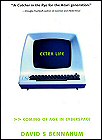
 Story: BBS veteran Rob O’Hara relives the pre-internet glory days of the bulletin board system, from his first computer and his first screamin’ fast 1200 baud modem (a luxury in those dial-up days) to the active Commodore 64 warez scene to the death of the BBS era, and how friendships and relationships from those days have stretched even into his life on the ‘net as we know it today.
Story: BBS veteran Rob O’Hara relives the pre-internet glory days of the bulletin board system, from his first computer and his first screamin’ fast 1200 baud modem (a luxury in those dial-up days) to the active Commodore 64 warez scene to the death of the BBS era, and how friendships and relationships from those days have stretched even into his life on the ‘net as we know it today.
Review: In the interests of disclosure, I’m going to point out up front that Rob has reviewed DVDs, books and Commodore 64 games aplenty for theLogBook.com. So if you love this book, and if you’re of a certain age, you will love this book, please remember that you can always come back here and soak up more of his fine writing.
I say with certainty that you’ll love “Commodork” because, having heard what some other folks are saying about this book, it’s quickly become clear that there’s a wealth of shared experience among those of us who were “online” back in the days when it was almost an elite thing, when only the technically adept could connect and configure a modem and even claim to be “online.”
















